Present World, on Multiple Realities and Romantic Desire in the Work of Toon Berghahn
By Mischa Rakier © 2011
Towards the end of 2007 the show Silent Hill opens in Gallery De Meerse in Hoofddorp. It is an intriguing solo exhibition of landscapes painted by the Dutch artist Toon Berghahn (Amsterdam, 1970). Various outlines of bushes alternate with protruding tree trunks in an elevated landscape, interspersed with an open area or an unexpected magnificent panorama of the scenery beyond. Many characteristic grown trees seem to give the whole its own signature. As if nature has created something very special for you, the traveller, who has been on the road for hours. Far away from civilisation, entering deeper into the wilderness. At a large distance from large urban conglomerations like New York City, where capital is continuously circulated under the unscrupulous mantra of near unlimited production and consumption without any kind of conscientious objection. Berghahn uses real dollar bills in his paintings to demonstrate this, for example, in the work Central Park (2006). Bank notes literally function as a visual means in this painting. At the same time it can be read as a comment on the marketplace, where all art works eventually become commodities. Manhattan with its high rises, and even the city park itself as an important part of the metropolitan infrastructure, are all built with this money. The air is poisonous and yellow. This is not the desired sunlight for a romantic stroll in the park. Heavy smog breaks the incidental light in its corresponding part of the spectrum. A leafless tree projects out of the foreground. The fast-paced urban noise with its honking cars has faded away by now. Here the world is silent and noiseless. There’s not a living soul around. It is as empty as the shallow world of unrestrained capitalism - the painter seems to show us. It is cold here. Winter has finally made its appearance.
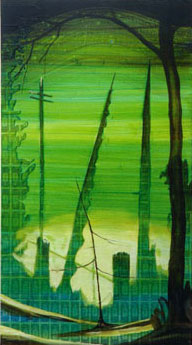 |
| Silent Hill 2006 225 X 120 cm mixed media on panel |
The image of the frozen city is inscribed in your memory and slowly fades into the gradually even more indistinct becoming path on which you walk. Traces of the human world, which you have decided to leave, can still be found around you. For example, a piece of overgrown concrete with jumbled rusty iron wires sticking out. In the distance lies the viaduct behind which you crossed a while ago. Just like in the painting Evening Glory (2005), this functional construction seems to connect two different worlds. In the foregroundsome trees stand firm. Stripped of all their leaves, neither living nor dead, they act as witnesses. Graceful guardians of a passage to a world beyond. A post-apocalyptic world permeated with strange but beautiful light that casts this newly discovered landscape in a shower of unusual colours and unfamiliar shadows. As if the day-to-day reality, which you have become accustomed to, has suddenly been replaced by an ephemeral version of the same existence, however this time with no inhabitants.
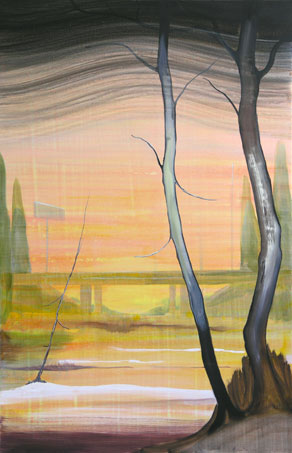 |
| Evening glory 2005 200 X 135 cm Acrylic and oil on canvas |
In the painting Babel (2007) abandoned modernistic architecture forms the stage for an infinite world of the senses in which the “present onlooker” is able to wander around in the first person. Free roaming this is called so appropriate in the world of video games. As a game player you are able to explore the whole space within the premeditated world of the computer game; free from the storylines, subplots or any other restrictions, you are allowed to do as you please. Similarly your eyes and mind can roam without any restraint over the pictorial plane, through the painted landscape. The thin layers of paint applied over each other form together a representation that evokes many associations and connotations. In the past Berghahn used to paint on canvas, but in recent years he frequently makes use of wooden panels glued with paper. Paper requires quite a different approach and treatment in comparison with prepared linen. The material is more direct and has a certain delicate fragility, an important factor in the final result.
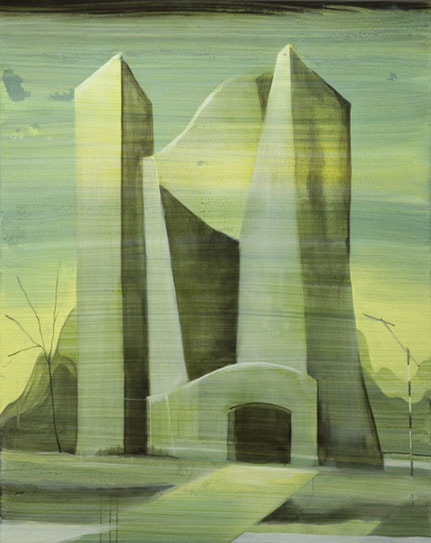 |
| Babel 160 X 120 cm 2007 Mixed media om wood |
At a second glance some of Berghahn’s paintings resemble the buildings, hallways and the typical atmospheric light often found in computer animations and video games. This is also the case in many of the works shown in De Meerse. The title of the exhibition is taken from the survival horror game Silent Hill, released by Konami Digital Entertainment in 1999, and which was made into a feature film (Christophe Gans, 2006) some years later. Toon Berghahn uses a number of carefully selected stills taken from the platform game as material and as point of departure for his paintings. Also worth noting is the fact that the creators of the game are said to have been inspired by specific scripts and film techniques used in the horror film genre, like in the movie Jacobs Ladder (Adrian Lyne, 1990). In order to arouse more fear and involvement during gameplay, the designers opted for a more psychological approach, especially focussing on the player’s mental perception of the game. One of the ways to achieve this was to create an atmosphere filled with anticipated uneasiness and suspense. Abandoned buildings in a desolate environment. A place where nature slowly takes over both the cultural highlights and the debris of human existence. And everywhere this distinctive, atmospheric over-all light is omnipresent.
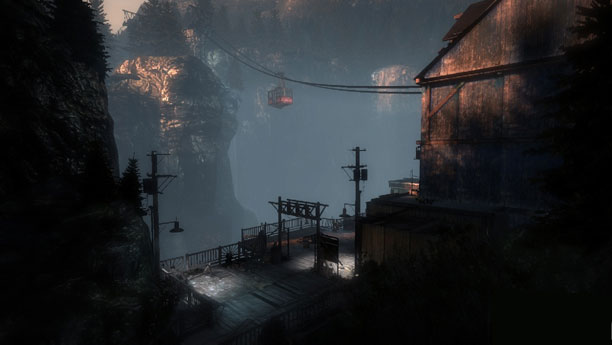 |
| Silent Hill Konami Digital Entertainment Keiichiro Toyama |
These are several of the elements that appear in Berghahn’s paintings. However, in both the nerve-racking horror movie and video game a psychotic murderer or brainless creep may lurk behind each door, corner or tree who is determined to kill the movie’s protagonist or the game player’s avatar. Berghahn’s work, on the other hand, is imbued with tranquil reflection and a contemplative silence. A sincere deliberation on how to step out of the vicious circle that continues to lead society towards excessive mass production, violence and pollution. Fortunately, there is still hope for how we could go back and reverse this situation, and should continue together in some better way. This might be the reason why future, present and past somehow appear to be manifest in many of his paintings simultaneously. Take for example his works in which modernistic architecture is the central theme. These are functional, utilitarian buildings - often part of, or related to the New Objectivity movement - from the 20th century, which are subsequently projected out of a post-apocalyptic future into a “conceived” present. In (the depiction of) the painting one can speak of a multiple reality that exists through the painting itself (the canvas, the paint) concurrently with our actuality. As a matter of fact, all we have to do is synchronize.
Berghahn’s paintings also emanate a great longing. Perhaps it is a wish to scrutinize all aspects of the world represented by experiencing and living within them ourselves. As a matter of fact, many places depicted in Berghahn’s paintings have been visited and experienced by the artist at first hand. For example, he lived a while in New York and has also hiked a number of times deep into the mountains in order to witness the magnificence of the landscape and capture its splendor in sketches and snap shots on which his later paintings are partly based. His work seem to breaths the same kind of longing or desire which can be found in the paintings of the great German landscape painter Caspar David Friedrich (1774-1840), who Berghahn mentions as being a major influence and source of inspiration.
In the world of painting, Friedrich is generally recognized as the most important advocate of Romanticism. Most of us are familiar with his famous painting Der Wanderer über dem Nebelmeer (The Wanderer Above a Sea of Fog, 1818), which is currently part of the collection on view in the Hamburger Kunsthalle. In this work a man - possibly the painter himself - stands upon a high cliff, looking out over the raging sea. The roaring waves crash onto the underlying rocks with a force that causes the water to splash to enormous heights. This painting illustrates well how insignificant man really is while standing before the overwhelming forces of nature that overpower him both physically and mentally, just a single step away from the alluring abyss that leads to an inevitable end. In this very moment, with his heart beating in his throat and facing death itself, in all his essence man is able to understand profoundly that he is alive!
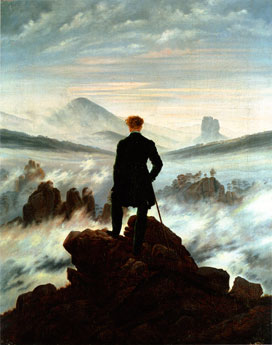 |
Caspar David Friedrich |
This experience is an excellent example of the Sublime, a concept used and elaborated on by the Irish philosopher and politician Edmund Burke (1729-1797) in his essay A Philosophical Enquiry into the Origin of Our Ideas of the Sublime and Beautiful from 1757, and soon followed by the German Enlightenment philosopher Immanuel Kant (1724-1804). According to Burke the Sublime is greatness, sensational and omnipotent. Something that is so elevated, infinite even, that the human mind simply cannot grasp this notion. Since the Sublime is connected in a causal way to fear, especially fear of death, it has the power to agitate man severely. Uniquely, in the case of Burke’s essay he considers the experience of the Sublime to be greater than the experience of Beauty, because the Sublime knows how to affect the body and mind with a much stronger intensity. Even though the Sublime is able to instil an awful feeling of horror, one may still gain pleasure from the notion that this perception is in fact imaginary. When looking again at the famous painting of Friedrich one is able to observe, or reasonably assume, that there is always just enough leeway that keeps the walker from a clear and present death. This is also the case with the characters in the horror movie and video game Silent Hill. The empathic viewer or participating player is sitting on the edge of his chair in anticipation, knowing that something terrible is about to happen. And when the inevitable finally occurs you always know that it is only the protagonist in the movie or your avatar in the video game that perishes, and that you yourself are luckily still in one piece. Still alive and an experience richer you can step out of the virtual world and back into everyday life. A comforting thought.
More importantly, in the works of both Friedrich and Berghahn there is a contemplation of nature and culture through perceiving our “metaphysical dimension” by means of painting itself. In a recent series of works Toon Berghahn has painted a number of rooms in museums, for example SM (2011). This work almost certainly refers to an exhibition space in the Stedelijk Museum in Amsterdam. The painter must have visited the place once more in the year that the museum was opened temporarily during extensive renovation work to the building. And it must have been quite an exceptional experience. Perhaps in a way similar to the vital sensation of truly enduring the power of nature, which he frequently refers to, and from which the romantic desire is present in the painting itself. Likewise the titles of his paintings: beneath the surface (Beneath the Surface, 2011) and the reflections (Reflections#2, 2010) it fizzes as if there is an electric current present (Electric, 2011) or as if an echo (Echo, 2011) resonates (The Gallery, Resonance, 2009) within the depiction, within the painting and even within ourselves. An articulate expression made by a fascinating painter. Come and see for yourself!
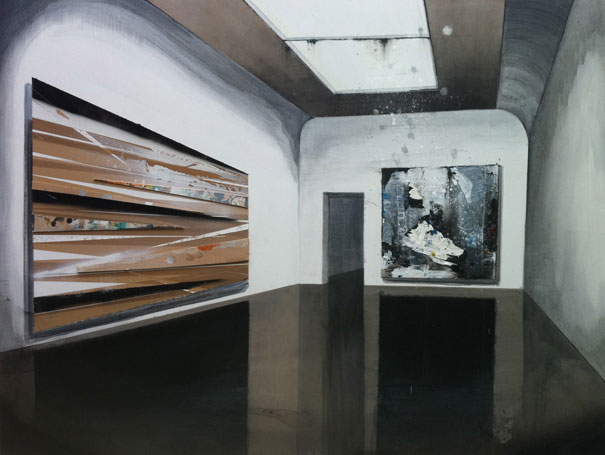 |
| Beneath the surface 122 X 162 cm 2011 mixed media on panel |